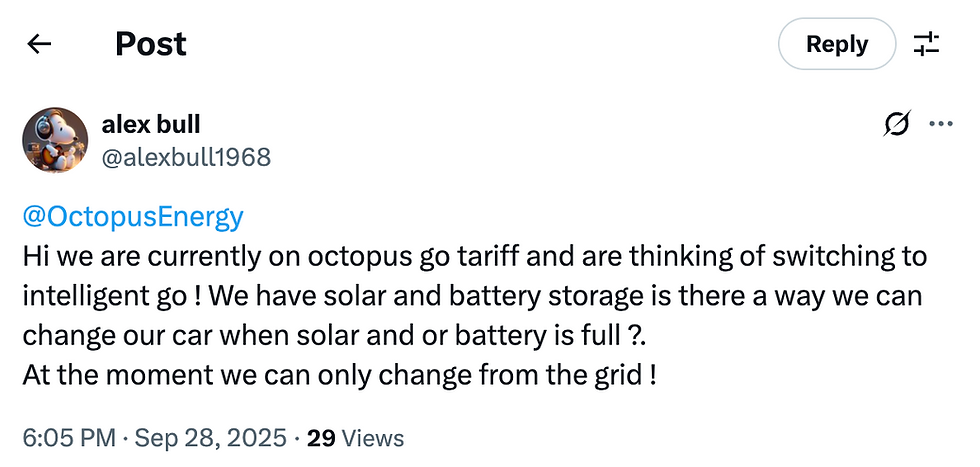Why can't I bank a solar generated summer kWh to use in the winter?
- Philip Steele
- 2 days ago
- 3 min read
Most home solar systems will export on sunny days; our system regularly exports 20+ kWh on a summers day. But solar systems in the UK generate 15% to 20% of their summer output in the winter and obviously our electricity use is much higher in the winter.
A customer asked me how could they save that lovely spare summer energy for the winter. They were asking if there's a way we could 'bank' their solar generated energy to then draw from in the winter.

One answer is store it instead of exporting which is referred to as longterm storage but hasn't really been cracked yet because the cost of the method/technology and/or medium used to store that energy is too high. A typical home battery is around 10kWh so you'd need a lot of batteries to store several weeks of surplus summer energy for use in the winter and that would be horrendously expensive. Pumped water (height difference between two lakes, or ponds) is one type of longterm storage but that needs a mountain and some lakes but at least the storage (water) would be almost free. The nearest I've seen is Cheesecake Energy using reconditioned engines to store compressed air but still not something to just set up in the garden.
If it can't be stored long-term then we need to look at the way we account for energy and find a way of doing it there - the customer's idea of a 'bank'.
Our Octopus Agile import and export tariff average, lowest and highest rates (https://agile.octopushome.net/historical-data) show broadly the difference between summer and winter (although I've not adjusted for geopolitical impacts on wholesale costs nor averaged over several years).

If I banked the summer export I'd forego an average 8.44p/kWh and save on an average winter import of 24.50p/kWh - a spread of 16.06p/kWh. In the year to today (10/11/2025) I've generated 3,999kWh of which 764kWh has been exported so that's a £122.54 potential saving if I could convert that summer export to winter consumption.
That's far in excess of my 13.5kWh battery.
The question is could we, Octopus, hold those 764kWh like a savings account instead of receiving an export credit and then use them in the winter.
But the problem with doing that is demonstrated with the Agile tariff. Agile is calculated from the wholesale market so this is applicable even if we tried to create a summer/winter bank of energy. We wouldn't be able to store that energy either so we'd be selling the summer export at low rate than and then similarly we'd have to buy it for you in the winter at a higher rate.
And it gets worse if instead of using the average of the Agile rates we consider that most of the surplus summer energy is generated in the middle of the day but the winter demand is skewed towards the evening and in particular the peak 4.00pm to 7.00pm period.
One answer might be to create a ratio split - e.g. three summer kWh's is worth one winter peak period kWh but that starts to get complicated quickly if we try to have different ratios for the time of day as well as having to forecast and agree (contract terms, like a tariff) the ratio for the year ahead.
The fact tariffs are priced means money is actually doing the same thing as that ratio in reality. You're simply storing up credit to offset increased cost in the winter.
Currently fixed 12 month import tariffs are modelled without any consideration of solar self-use and solar export - a standard profile (e.g. Profile Class 1 is a regular domestic assumption) assumes what the annual consumption looks like. If this were revised to take into account the impact of solar self-consumption and export we'd have quite a different import profile. And if that were coupled with a zero-rate export tariff then the value of the export can be baked into the cost of the import to give a merged kind of tariff.
My 764kWh hasn't quite got banked but it does at least get valued, on the wholesale side of things, to define my 12M fixed import tariff. Interestingly this might not be allowed as export tariffs are supposed to be non-zero so would we be forced to apply even a 1p/kWh export rate simply to meet the rules?



Comments